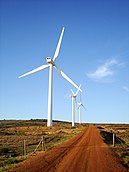
A | B | C | D | E | F | G | H | CH | I | J | K | L | M | N | O | P | Q | R | S | T | U | V | W | X | Y | Z | 0 | 1 | 2 | 3 | 4 | 5 | 6 | 7 | 8 | 9
| Part of a series on |
| Sustainable energy |
|---|
 |
Renewable energy (or green energy) is energy from renewable natural resources that are replenished on a human timescale. The most widely used renewable energy types are solar energy, wind power and hydropower. Bioenergy and geothermal power are also significant in some countries. Some also consider nuclear power a renewable power source, although this is controversial. Renewable energy installations can be large or small and are suited for both urban and rural areas. Renewable energy is often deployed together with further electrification. This has several benefits: electricity can move heat and vehicles efficiently, and is clean at the point of consumption.[1][2] Variable renewable energy sources are those that have a fluctuating nature, such as wind power and solar power. In contrast, controllable renewable energy sources include dammed hydroelectricity, bioenergy, or geothermal power.
Renewable energy systems have rapidly become more efficient and cheaper over the past 30 years.[3] A large majority of worldwide newly installed electricity capacity is now renewable.[4] Renewable energy sources, such as solar and wind power, have seen significant cost reductions over the past decade, making them more competitive with traditional fossil fuels.[5] In most countries, photovoltaic solar or onshore wind are the cheapest new-build electricity.[6] From 2011 to 2021, renewable energy grew from 20% to 28% of global electricity supply. Power from sun and wind accounted for most of this increase, growing from a combined 2% to 10%. Use of fossil energy shrank from 68% to 62%.[7] In 2022, renewables accounted for 30% of global electricity generation, and are projected to reach over 42% by 2028.[8][9] Many countries already have renewables contributing more than 20% of their total energy supply, with some generating over half or even all their electricity from renewable sources.[10][11]
The main motivation to replace fossil fuels with renewable energy sources is to slow and eventually stop climate change, which is widely agreed to be caused mostly by greenhouse gas emissions. In general, renewable energy sources cause much lower emissions than fossil fuels.[12] The International Energy Agency estimates that to achieve net zero emissions by 2050, 90% of global electricity generation will need to be produced from renewable sources.[13] Renewables also cause much less air pollution than fossil fuels, improving public health, and are less noisy.[12]
The deployment of renewable energy still faces obstacles, especially fossil fuel subsidies,[14] lobbying by incumbent power providers,[15] and local opposition to the use of land for renewables installations.[16][17] Like all mining, the extraction of minerals required for many renewable energy technologies also results in environmental damage.[18] In addition, although most renewable energy sources are sustainable, some are not. For example, some biomass sources are unsustainable at current rates of exploitation.[19]
Overview

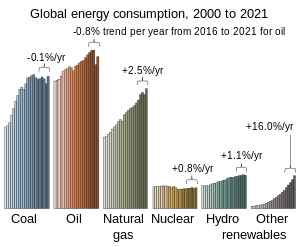
Definition
Renewable energy is usually understood as energy harnessed from continuously occurring natural phenomena. The International Energy Agency defines it as "energy derived from natural processes that are replenished at a faster rate than they are consumed". Solar power, wind power, hydroelectricity, geothermal energy, and biomass are widely agreed to be the main types of renewable energy.[22] Renewable energy often displaces conventional fuels in four areas: electricity generation, hot water/space heating, transportation, and rural (off-grid) energy services.[23]
Although almost all forms of renewable energy cause much fewer carbon emissions than fossil fuels, the term is not synonymous with low-carbon energy. Some non-renewable sources of energy, such as nuclear power,[contradictory]generate almost no emissions, while some renewable energy sources can be very carbon-intensive, such as the burning of biomass if it is not offset by planting new plants.[12] Renewable energy is also distinct from sustainable energy, a more abstract concept that seeks to group energy sources based on their overall permanent impact on future generations of humans. For example, biomass is often associated with unsustainable deforestation.[24]
Role in addressing climate change

As part of the global effort to limit climate change, most countries have committed to net zero greenhouse gas emissions.[26] In practice, this means phasing out fossil fuels and replacing them with low-emissions energy sources.[12] At the 2023 United Nations Climate Change Conference, around three-quarters of the world's countries set a goal of tripling renewable energy capacity by 2030.[27] The European Union aims to generate 40% of its electricity from renewables by the same year.[28]
Other benefits
Renewable energy is more evenly distributed around the world than fossil fuels, which are concentrated in a limited number of countries.[29] It also brings health benefits by reducing air pollution caused by the burning of fossil fuels. The potential worldwide savings in health care costs have been estimated at trillions of dollars annually.[30]
Intermittency

The two most important forms of renewable energy, solar and wind, are intermittent energy sources: they are not available constantly, resulting in lower capacity factors. In contrast, fossil fuel power plants are usually able to produce precisely the amount of energy an electricity grid requires at a given time. Solar energy can only be captured during the day, and ideally in cloudless conditions. Wind power generation can vary significantly not only day-to-day, but even month-to-month.[31] This poses a challenge when transitioning away from fossil fuels: energy demand will often be higher or lower than what renewables can provide.[32] Both scenarios can cause electricity grids to become overloaded, leading to power outages.
In the medium-term, this variability may require keeping some gas-fired power plants or other dispatchable generation on standby[33][34] until there is enough energy storage, demand response, grid improvement, and/or baseload power from non-intermittent sources. In the long-term, energy storage is an important way of dealing with intermittency.[35] Using diversified renewable energy sources and smart grids can also help flatten supply and demand.[36]
Sector coupling of the power generation sector with other sectors may increase flexibility: for example the transport sector can be coupled by charging electric vehicles and sending electricity from vehicle to grid.[37] Similarly the industry sector can be coupled by hydrogen produced by electrolysis,[38] and the buildings sector by thermal energy storage for space heating and cooling.[39]
Building overcapacity for wind and solar generation can help ensure sufficient electricity production even during poor weather. In optimal weather, it may be necessary to curtail energy generation if it is not possible to use or store excess electricity.[40]
Electrical energy storage
Electrical energy storage is a collection of methods used to store electrical energy. Electrical energy is stored during times when production (especially from intermittent sources such as wind power, tidal power, solar power) exceeds consumption, and returned to the grid when production falls below consumption. Pumped-storage hydroelectricity accounts for more than 85% of all grid power storage.[41] Batteries are increasingly being deployed for storage[42] and grid ancillary services[43] and for domestic storage.[44] Green hydrogen is a more economical means of long-term renewable energy storage, in terms of capital expenditures compared to pumped hydroelectric or batteries.[45][46]
Mainstream technologies

Solar energy
| Installed capacity and other key design parameters | Value and year |
| Global electricity power generation capacity | 1419.0 GW (2023)[48] |
| Global electricity power generation capacity annual growth rate | 25% (2014-2023)[49] |
| Share of global electricity generation | 5.5% (2023)[50] |
| Levelized cost per megawatt hour | Utility-scale photovoltaics: USD 38.343 (2019)[51] |
| Primary technologies | Photovoltaics, concentrated solar power, solar thermal collector |
| Main applications | Electricity, water heating, heating, ventilation, air conditioning (HVAC) |


Solar power produced around 1.3 terrawatt-hours (TWh) worldwide in 2022,[10] representing 4.6% of the world's electricity. Almost all of this growth has happened since 2010.[52] Solar energy can be harnessed anywhere that receives sunlight; however, the amount of solar energy that can be harnessed for electricity generation is influenced by weather conditions, geographic location and time of day.[53]
There are two mainstream ways of harnessing solar energy: solar thermal, which converts solar energy into heat; and photovoltaics (PV), which converts it into electricity.[12] PV is far more widespread, accounting for around two thirds of the global solar energy capacity as of 2022.[54] It is also growing at a much faster rate, with 170 GW newly installed capacity in 2021,[55] compared to 25 GW of solar thermal.[54]
Passive solar refers to a range of construction strategies and technologies that aim to optimize the distribution of solar heat in a building. Examples include solar chimneys,[12] orienting a building to the sun, using construction materials that can store heat, and designing spaces that naturally circulate air.[56]
From 2020 to 2022, solar technology investments almost doubled from USD 162 billion to USD 308 billion, driven by the sector's increasing maturity and cost reductions, particularly in solar photovoltaic (PV), which accounted for 90% of total investments. China and the United States were the main recipients, collectively making up about half of all solar investments since 2013. Despite reductions in Japan and India due to policy changes and COVID-19, growth in China, the United States, and a significant increase from Vietnam's feed-in tariff program offset these declines. Globally, the solar sector added 714 gigawatts (GW) of solar PV and concentrated solar power (CSP) capacity between 2013 and 2021, with a notable rise in large-scale solar heating installations in 2021, especially in China, Europe, Turkey, and Mexico.[57]
Photovoltaics
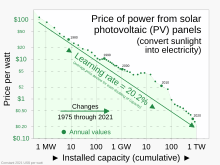
A photovoltaic system, consisting of solar cells assembled into panels, converts light into electrical direct current via the photoelectric effect.[60] PV has several advantages that make it by far the fastest-growing renewable energy technology. It is cheap, low-maintenance and scalable; adding to an existing PV installation as demanded arises is simple. Its main disadvantage is its poor performance in cloudy weather.[12]
PV systems range from small, residential and commercial rooftop or building integrated installations, to large utility-scale photovoltaic power station.[61] A household's solar panels can either be used for just that household or, if connected to an electrical grid, can be aggregated with millions of others.[62]
The first utility-scale solar power plant was built in 1982 in Hesperia, California by ARCO.[63] The plant was not profitable and was sold eight years later.[64] However, over the following decades, PV cells became significantly more efficient and cheaper.[65] As a result, PV adoption has grown exponentially since 2010.[66] Global capacity increased from 230 GW at the end of 2015 to 890 GW in 2021.[67] PV grew fastest in China between 2016 and 2021, adding 560 GW, more than all advanced economies combined.[68] Four of the ten biggest solar power stations are in China, including the biggest, Golmud Solar Park in China.[69]
Solar thermal
Unlike photovoltaic cells that convert sunlight directly into electricity, solar thermal systems convert it into heat. They use mirrors or lenses to concentrate sunlight onto a receiver, which in turn heats a water reservoir. The heated water can then be used in homes. The advantage of solar thermal is that the heated water can be stored until it is needed, eliminating the need for a separate energy storage system.[70] Solar thermal power can also be converted to electricity by using the steam generated from the heated water to drive a turbine connected to a generator. However, because generating electricity this way is much more expensive than photovoltaic power plants, there are very few in use today.[71]
Wind power
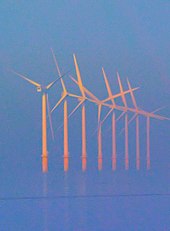
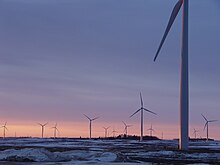

| Installed capacity and other key design parameters | Value and year |
| Global electricity power generation capacity | 1017.2 GW (2023)[73] |
| Global electricity power generation capacity annual growth rate | 13% (2014-2023)[74] |
| Share of global electricity generation | 7.8% (2023)[50] |
| Levelized cost per megawatt hour | Land-based wind: USD 30.165 (2019)[75] |
| Primary technology | Wind turbine, windmill |
| Main applications | Electricity, pumping water (windpump) |
Humans have harnessed wind energy since at least 3500 BC. Until the 20th century, it was primarily used to power ships, windmills and water pumps. Today, the vast majority of wind power is used to generate electricity using wind turbines.[12] Modern utility-scale wind turbines range from around 600 kW to 9 MW of rated power. The power available from the wind is a function of the cube of the wind speed, so as wind speed increases, power output increases up to the maximum output for the particular turbine.[76] Areas where winds are stronger and more constant, such as offshore and high-altitude sites, are preferred locations for wind farms.
Wind-generated electricity met nearly 4% of global electricity demand in 2015, with nearly 63 GW of new wind power capacity installed. Wind energy was the leading source of new capacity in Europe, the US and Canada, and the second largest in China. In Denmark, wind energy met more than 40% of its electricity demand while Ireland, Portugal and Spain each met nearly 20%.[77]
Globally, the long-term technical potential of wind energy is believed to be five times total current global energy production, or 40 times current electricity demand, assuming all practical barriers needed were overcome. This would require wind turbines to be installed over large areas, particularly in areas of higher wind resources, such as offshore, and likely also industrial use of new types of VAWT turbines in addition to the horizontal axis units currently in use. As offshore wind speeds average ~90% greater than that of land, offshore resources can contribute substantially more energy than land-stationed turbines.[78]
Investments in wind technologies reached USD 161 billion in 2020, with onshore wind dominating at 80% of total investments from 2013 to 2022. Offshore wind investments nearly doubled to USD 41 billion between 2019 and 2020, primarily due to policy incentives in China and expansion in Europe. Global wind capacity increased by 557 GW between 2013 and 2021, with capacity additions increasing by an average of 19% each year.[57]
Hydropower
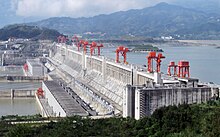
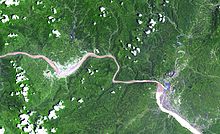
| Installed capacity and other key design parameters | Value and year |
| Global electricity power generation capacity | 1,267.9 GW (2023)[79] |
| Global electricity power generation capacity annual growth rate | 1.9% (2014-2023)[80] |
| Share of global electricity generation | 14.3% (2023)[50] |
| Levelized cost per megawatt hour | USD 65.581 (2019)[81] |
| Primary technology | Dam |
| Main applications | Electricity, pumped storage, mechanical power |
Since water is about 800 times denser than air, even a slow flowing stream of water, or moderate sea swell, can yield considerable amounts of energy. Water can generate electricity with a conversion efficiency of about 90%, which is the highest rate in renewable energy.[82] There are many forms of water energy:
- Historically, hydroelectric power came from constructing large hydroelectric dams and reservoirs, which are still popular in developing countries.[83] The largest of them are the Three Gorges Dam (2003) in China and the Itaipu Dam (1984) built by Brazil and Paraguay.
- Small hydro systems are hydroelectric power installations that typically produce up to 50 MW of power. They are often used on small rivers or as a low-impact development on larger rivers. China is the largest producer of hydroelectricity in the world and has more than 45,000 small hydro installations.[84]
- Run-of-the-river hydroelectricity plants derive energy from rivers without the creation of a large reservoir. The water is typically conveyed along the side of the river valley (using channels, pipes and/or tunnels) until it is high above the valley floor, whereupon it can be allowed to fall through a penstock to drive a turbine. A run-of-river plant may still produce a large amount of electricity, such as the Chief Joseph Dam on the Columbia River in the United States.[85] However many run-of-the-river hydro power plants are micro hydro or pico hydro plants.
Much hydropower is flexible, thus complementing wind and solar.[86] In 2021, the world renewable hydropower capacity was 1,360 GW.[68] Only a third of the world's estimated hydroelectric potential of 14,000 TWh/year has been developed.[87][88] New hydropower projects face opposition from local communities due to their large impact, including relocation of communities and flooding of wildlife habitats and farming land.[89] High cost and lead times from permission process, including environmental and risk assessments, with lack of environmental and social acceptance are therefore the primary challenges for new developments.[90] It is popular to repower old dams thereby increasing their efficiency and capacity as well as quicker responsiveness on the grid.[91] Where circumstances permit existing dams such as the Russell Dam built in 1985 may be updated with "pump back" facilities for pumped-storage which is useful for peak loads or to support intermittent wind and solar power. Because dispatchable power is more valuable than VRE[92][93] countries with large hydroelectric developments such as Canada and Norway are spending billions to expand their grids to trade with neighboring countries having limited hydro.[94]


